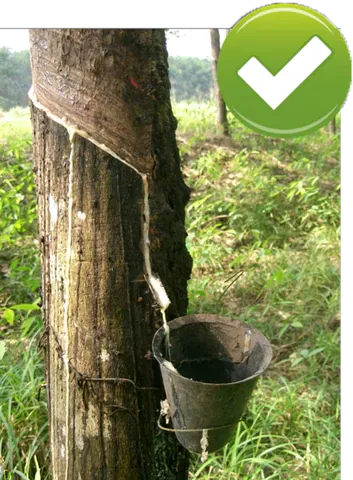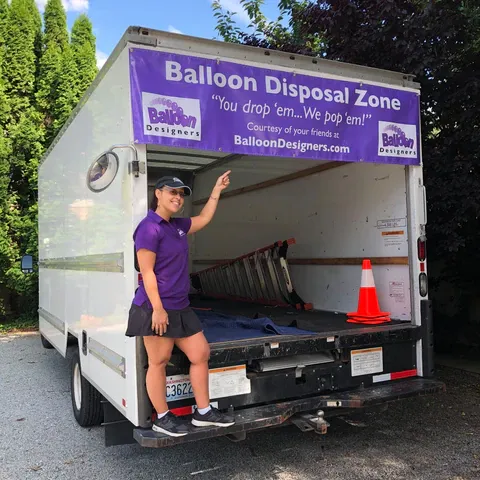Balloons & the Environment
Here are five VERY important facts to know about balloons and the environment.
#1 - Latex balloons are NOT made from plastic - There's a huge myth out there that your average latex party style balloon is made from plastic and will live in a landfill for centuries. Nothing could be further than the truth. Latex is a biodegradable, naturally occurring material that, while not compostable in our every day sense, will absolutely break down over a relatively short period of time.
While it is true that balloon manufacturers add chemicals into the process to create the balloons (dyes, silicone, preservatives, etc.) which can slow down the break down process, a typical latex balloon won't last longer than a decade in a landfill. Compared to the centurial lifespan of plastic bottles, bags and straws, this time frame feels pretty insignificant.
#2 - Latex balloons are a SUSTAINABLE industry - Raw latex actually comes from rubber tree sap in various jungles around the world. And unlike the lumber industry which cuts down trees in order to produce their materials, latex is acquired by merely making small controlled slices in the bark of the trees, much like how maple syrup is collected. This means that not only are trees not harmed in the process of producing balloons, it means that the balloon industry WANTS to protect the jungles of the world, making us an extremely green industry in general.

#3 - The world is NOT running out of helium - The shortages of helium over the last several years have not been because of environmental reasons, but rather commercial ones. Massive buyouts of helium lots by a limited number of companies lead to increased pricing and lower availability. Helium processing centers often have to be closed for routine and required maintenance, leading to lower production levels. Even global conflicts like the war in Ukraine have had an effect on helium access, with Russia being a supplier of helium to the world.
Still not sure? Well, here's a really good indicator for you. If the massive helium-filled parade balloons continue to float above New York City in the Macy's Thanksgiving Day Parade, then there is NOT a shortage of helium
#4 - Helium balloons do NOT deprive the medical industry of helium - Everyone knows that diamonds are not all the same. They are measured at different levels, leading to some diamonds being worth far more than others. The same idea applies to the purity of helium, and different qualities of helium are used in different ways.
You see, helium is rated on a scale of 1 to 6, with a grade of "6" being pure helium, and anything below that contains "impurities" (mostly other gasses like oxygen and nitrogen mixed in). If helium is rated at 6.0 on the scale, that portion is held aside for microchip production (they use helium to weld chips in since it is an inert gas, meaning non-reactive to heat or flame). If the helium is rated between 5.5 and 5.9, then it's classified as medical grade for use in MRI machines.
And helium that is rated at a score of 4.0 or lower? Yep, that's considered balloon grade helium (aka the lowest degree for commercial use). It's simply too diluted by other gasses to be effective in these other roles, which means the only thing it's really any good for is for balloons.
Here's another way you can look at it. No one would ever confuse a hamburger patty for a ribeye. Yes, they're both made of beef, but they're simply NOT the same thing...
#5 - Balloon RELEASES are NOT good for the environment - Balloons enjoyed in a responsible manner are a fun and dare we say "uplifting" way to celebrate a milestone. But releasing helium balloons into the air can cause all kinds of problems. Because balloons don't break down fast enough to be compostable, they return to the earth as litter, plain and simple. On top of that, wildlife can mistake a colorful broken balloon as something to eat, and while most incidents like this result in a "rejected meal", some animals have been known to choke and die on pieces of rubber in their throats.
When it come to foil / mylar balloons, even more problems are possible. These metallic balloons conduct electricity, and should they get caught up in power lines, they can pose both a safety hazard to anyone trying to collect them as well as potentially overload systems and knock out power until repairs can be made.
This is why the balloon industry in 2018 made a collective vow to no longer support the act of releasing balloons into the air for any reason. Whether it's one balloon or 1000, the balloon industry has agreed that nothing good can come from such practices.
We at Balloon Designers will NOT sell balloons to a customer that we KNOW is planning to release them into the air. In addition, we highly advise all our clients against having loose or potentially loose balloons near open bodies of water as gusts of wind are frequent and likely to blow the balloons into the aquatic wildlife below.
In addition, Balloon Designers offers a complimentary balloon disposal service at one of Seattle's largest annual outdoor events, the Seattle Pride Parade. At the end of the parade route, our truck is there to collect any and all unwanted balloons from the parade contingencies once they have completed their route. This way we know the leftover parade decorations will be disposed of responsibly and professionally, regardless of who they purchased them from.

Sources for this information:

8606 Preston-Fall City Rd SE, Issaquah, WA, United States
Serving Seattle WA area and surrounding areas including: Bellevue, Kirkland, Medina, Redmond, Renton, Issaquah, Sammamish and many more.
All Rights Reserved | Balloon Designers | Website by Balloon Suite
